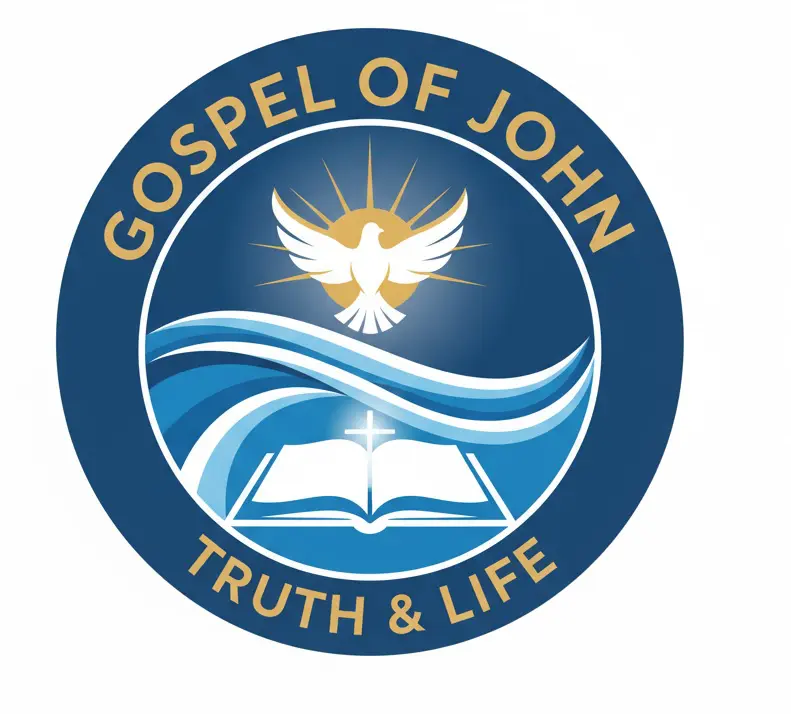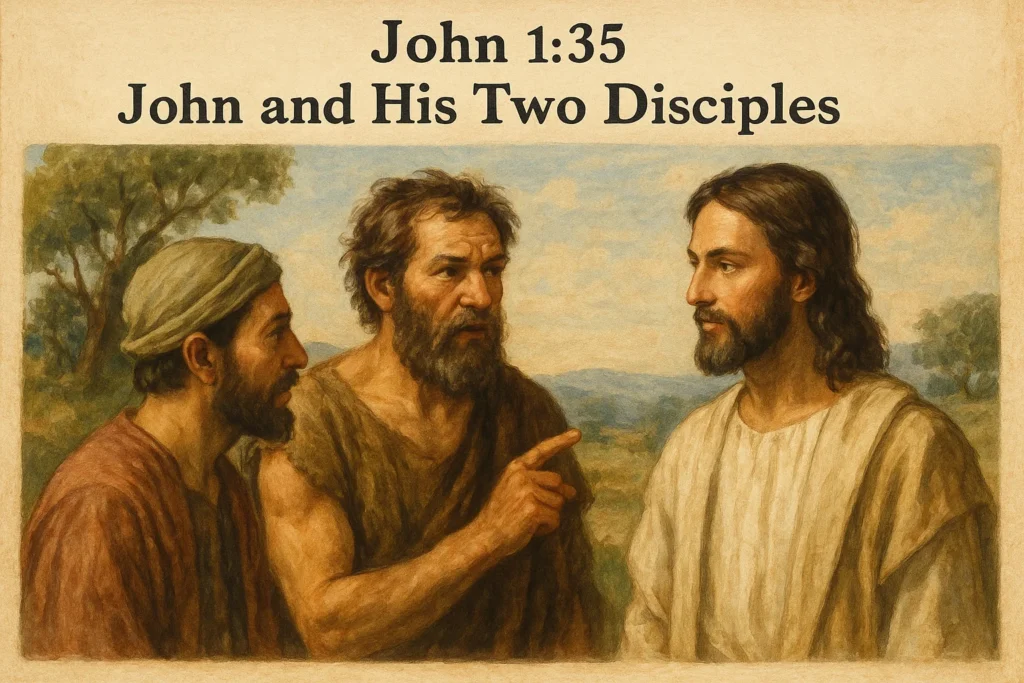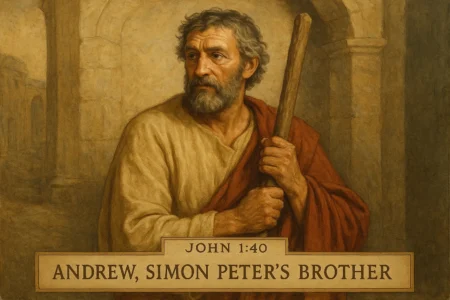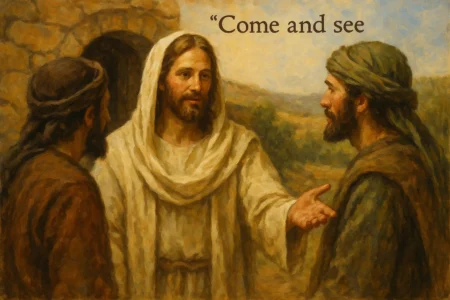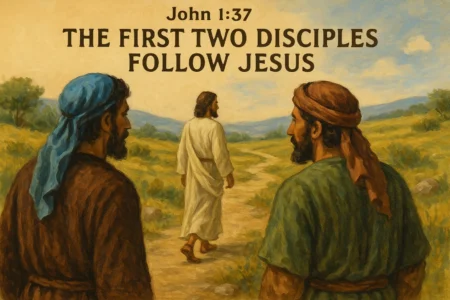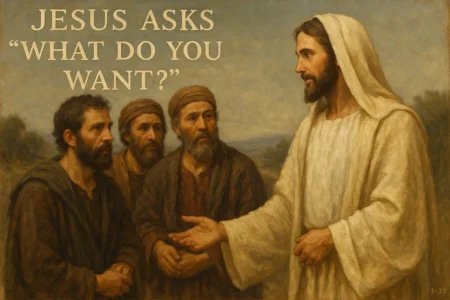John’s Gospel. Chapter 1. It’s not just a start; it’s a sprint. It rockets from “in the beginning” with God to the mud-and-sandals reality of the first disciples dropping everything.
And right in the thick of it, there’s this quiet moment. Barely a speed bump.
John the Baptist stands with two of his guys, points at Jesus, and… everything changes. The entire Christian movement pivots on this one, tiny scene. This John 1:35 commentary is all about that moment. We’re going to break down the people, the words, and the earth-shattering choice that unspools from this brief encounter.
This isn’t just dusty theology. This passage gets to the heart of what it feels like to have your world flipped upside down by one single truth. It’s about that gut-check moment when a teacher points beyond himself, and you have to decide.
Will you follow?
More in John Chapter 1 Category
Key Takeaways
- A Clean Handoff: John 1:35-37 is the critical handoff. It’s the official passing of the torch from John the Baptist’s ministry to Jesus’s.
- Testimony is the Spark: The disciples’ entire journey lights up not from a miracle, but from John’s simple, direct testimony: “Behold, the Lamb of God!”
- Meet the First Followers: This passage introduces us to the very first disciples. One is Andrew. The other is, as we’ll see, John, the author of the book himself.
- Jesus’s First Words: Jesus’s first recorded question in this Gospel is, “What do you seek?” It’s a question that cuts straight to the heart of all who would follow him.
- The Open Invitation: The disciples’ reply, “Where are you staying?” is met with the simple, profound invitation, “Come and you will see.” This is a call to relationship, not just information.
What’s Really Happening in This Scene? Setting the Stage
So, to get why this matters, you need to know what happened yesterday. The day before, John the Baptist spots Jesus in the crowd. He points and basically shouts, “Behold, the Lamb of God, who takes away the sin of the world!” (John 1:29).
This was a theological grenade. He just tagged Jesus as the ultimate sacrifice for everyone.
Now, it’s “the next day” (v. 35). The air is still buzzing from that announcement. But this time, it’s different. John’s not preaching to the masses. He’s just… standing there. With two of his own disciples. It’s a quiet, private moment.
He’s not announcing Jesus to the world anymore. He’s directing his best men to their new master. His job is almost over.
Why Does John Repeat “Behold the Lamb of God”?
Jesus walks by, and in verse 36, John “looked at Jesus… and said, ‘Behold, the Lamb of God!'”
Why say it again?
Because yesterday was the public announcement. Today is the personal introduction. He’s not just teaching a class anymore. He’s pointing to a person. “There. That’s the guy I told you about.”
I had this college professor, Dr. Harris. Taught medieval history. He spent a whole semester talking about the “Scholastic mind,” this super-abstract 12th-century way of thinking. It was just… words. Theory. Then one day, he walks in, slams a replica of a Gothic arch keystone on the desk, and says, “This. This is the Scholastic mind in stone. All that theory, all those forces… they all crash together right here.”
And bam. It clicked. An entire semester suddenly made sense.
That’s exactly what John is doing. He took this massive, abstract idea of a Messiah and just… pointed. “Behold. There He is. All of history converges on Him.” He made the abstract tangible.
What Did “Lamb of God” Even Mean to a First-Century Jew?
We hear “Lamb of God” and our minds jump straight to the cross. Easy for us.
But for these two Jewish disciples? That phrase was a sonic boom. It would have instantly lit up a whole switchboard of meanings from their entire history.
- The Passover Lamb: First thing? Passover. The lamb whose blood saved their ancestors from death in Egypt. It was the symbol of rescue and deliverance.
- The Sacrificial Lamb: Next, they’d think of the Temple. The lamb sacrificed every single day—a constant, bloody reminder that sin is real and needs a payment.
- The Suffering Servant: And they’d know the scrolls. They’d hear Isaiah 53, the prophecy of the Servant who is “like a lamb… led to the slaughter” (Isaiah 53:7). The one who would suffer for others.
When John said “Lamb of God,” he was mashing all of this together—rescue, payment, prophecy—into one shocking title. He wasn’t just saying, “He’s a good teacher.” He was saying, “He is the one-and-only, sin-bearing, world-saving sacrifice from God Himself.”
You can see why they were floored.
What Finally Made Those Two Disciples… Leave?
Verse 37 hits like a quiet thunderclap: “The two disciples heard him speak, and they followed Jesus.”
That’s it.
They hear. They go. Their lives just took a hard right turn, and they’re never coming back.
Look, this wasn’t an impulse buy. These guys were serious. They were dedicated followers of John. They’d already left their old lives to follow him into the desert, committing to repentance, waiting for the big “next thing.” And now, their own trusted leader points. And they just… leave him.
Think about the guts that took. It’s one thing to follow a new idea; it’s another to leave a mentor you trust.
I remember leaving a safe marketing job to try and make it as a writer. I was sick to my stomach. The job was fine. It was a paycheck. It was safe. But a mentor of mine, a guy I really looked up to, read some stuff I’d written. He just looked at me and said, “This. This is what you’re built for. That other thing is just a job.”
His words were the push I needed. That’s where these disciples were. They were in a “good” spot with John. But John, their hero, pointed and said, “No, He’s the one. He’s what you’ve really been looking for.” That testimony was all it took to leave the good for the absolute greatest.
Why Did Jesus Ask, “What Do You Seek?”
So now you’ve got this picture. Two guys, walking behind Jesus. Just… following.
Is it awkward? Are they whispering? We don’t know.
But Jesus stops, turns, and looks right at them. His first words in this entire Gospel: “What do you seek?” (v. 38).
This isn’t “Hi, can I help you?” He cuts right through the small talk and goes straight for the heart. He’s not asking who they want. He’s asking why. What’s the motive? What’s the deep-down hunger that made you follow me? Are you here for a political show? A miracle? To get in on the ground floor of a new movement? Or is it something more?
That question—”What do you seek?”—still hangs in the air 2,000 years later. It’s a question Jesus is still asking us. When we crack open the Bible, when we walk into church, when we pray… what are we really after?
It’s the first and most important question.
Was “Rabbi, Where Are You Staying?” What They Really Meant?
Their answer is brilliant. They don’t really answer him at all.
Instead, they ask their own question: “Rabbi (which means Teacher), where are you staying?” (v. 38).
On one level, it’s just a practical question. “Where’s your house? Where can we talk?” But the Greek word for “staying” is menō. And this is a huge word for John. He uses it all through his book, and it means way more than just “where do you crash.”
It means “to abide,” “to remain,” “to live.”
Later, Jesus will say, “Abide (menō) in me, and I in you” (John 15:4).
So, were they just asking for His address? Or was their heart asking, “Where do you live? What is your source? And… can we live there, too?”
They came looking for a teacher, but they were already stumbling toward a home.
What’s So Special About “Come and You Will See”?
Jesus’s reply is the core of his message.
“Come and you will see” (v. 39).
He doesn’t give them a pamphlet. He doesn’t start a sermon. He doesn’t give them a list of rules. He just invites them. “Come. See for yourself.”
This is Christianity, in John’s gospel, boiled down to its essence. It’s not a philosophy you learn; it’s a person you experience. He refuses to be a subject they can just study from a safe distance. He says, “No, you have to be part of this.”
The text says, “So they came and saw where he was staying, and they stayed with him that day…”
And then it gives us this tiny, perfect detail: “…it was about the tenth hour.”
Four in the afternoon.
The author remembers the exact time. That’s an eyewitness. That’s the moment his life split into ‘before’ and ‘after.’ We don’t know what they talked about for those few hours. But it was enough.
Who Were These Two Mystery Disciples?
So who were these two guys?
The Bible tells us one of them right away. Verse 40: “One of the two… was Andrew, Simon Peter’s brother.” And what’s the first thing Andrew does? He sprints to find his brother, Peter, and says, “We found him. We found the Messiah!” (v. 41). The experience immediately creates an evangelist.
But… who was the other guy?
The Gospel never says.
This silence is the biggest clue in the book. All through this Gospel, the author calls himself “the disciple whom Jesus loved” or “the other disciple.” He keeps writing himself into the story but never uses his own name.
Every expert and scholar, from the very beginning, agrees: the unnamed disciple is John, the son of Zebedee. The man writing the book.
He’s telling us his own story. He’s telling us about the day he first met Jesus. That’s why he remembers it was 4 p.m.
Why Would John Leave His Own Name Out?
Why do that? Why write this incredible story and leave your own name out of it?
It’s a brilliant move.
First, it’s total humility. John is making it crystal clear that this book isn’t about him. It’s ‘The Gospel of Jesus Christ,’ not ‘The Autobiography of John.’ He gets his ego out of the way so we can see Jesus.
Second, by just being “the other disciple,” he leaves a space open for us. He invites the reader to step into that role. We’re supposed to put ourselves on that riverbank, hear the testimony, feel the fear and excitement, and accept the same invitation to “come and see.” His anonymity makes the story our story.
What Can We Learn from John the Baptist’s “Hand-Off”?
We can’t finish without talking about John the Baptist. This moment is his masterpiece.
His entire life was about one thing: “Prepare the way.” He was the signpost, not the destination. And here, in this quiet moment, his job is done. He watches his best men, guys he has poured his life into, literally turn their backs on him to follow someone else.
And he doesn’t just let them go. He sends them.
I once had to train a guy, Mark, to take over a project I’d run for years. It was my baby. I poured everything I knew into him. The day came for the hand-off. I introduced him to the team as the new lead, and I sat down. He stood up and started running my meeting.
I felt this gut-punch of pride and… irrelevance. I was so proud of him. But I also felt totally useless. My job was to make myself obsolete. It was a weird, painful kind of success.
John the Baptist felt that on a cosmic scale. He knew he had to “decrease” so Jesus could “increase” (John 3:30). His success wasn’t measured in how many followers he had, but in how many he could give away to the one who truly mattered.
So, What’s the “Big Idea” of This John 1:35 Commentary?
When you boil it all down, this tiny passage is the whole Christian journey in miniature. It’s a three-act play.
- It Starts with a Word (Testimony): The journey kicks off because they heard someone they trusted. John pointed and said, “He’s the one.” Faith almost always starts this way: hearing the truth from a credible witness.
- It Moves to a Walk (Invitation): But hearing isn’t enough. They had to move. They had to follow. And Jesus didn’t meet them with a test; He met them with an invitation. “Come and see.” It demands a step of faith toward a real person.
- It Lands in a “Stay” (Relationship): They “came and saw… and they stayed with him.” The invitation led to an encounter, and the encounter led to a relationship. That’s the goal. Not a one-time decision, but an ongoing life with Him.
This commentary on John 1:35 shows us it all starts with a look. John “looked” at Jesus. The disciples “heard” and “followed.” Jesus “turned” and “saw” them. This is a story about seeing and being seen. It’s the story of how one true sentence—”Behold, the Lamb of God”—can be the one thing that changes your entire life, and gives you the courage to ask, “Teacher, where are you staying?”
And the answer, today, is still the same.
“Come and you will see.”
For further reading on the cultural and historical context of first-century discipleship, the Perseus Digital Library at Tufts University offers a wide range of classical texts and resources.
FAQ
Why does John the Baptist repeat the phrase ‘Behold the Lamb of God’?
John repeats ‘Behold the Lamb of God’ to reinforce the identification of Jesus as the Messiah and the fulfillment of Old Testament prophecies, moving from a public declaration to a personal introduction.
What is the significance of John 1:35 in the Christian faith?
John 1:35 is significant because it marks the pivotal moment when the disciples personally recognize Jesus as the Lamb of God, signifying the transition from John’s ministry to Jesus’s, and inspiring the first followers to leave their former lives behind.
What did ‘Lamb of God’ mean to first-century Jews?
To first-century Jews, ‘Lamb of God’ embodied multiple meanings: the Passover Lamb symbolizing rescue, the sacrificial lamb representing atonement and sin payment, and the Suffering Servant from Isaiah predicting a suffering savior who would bear the sins of others.
What is the importance of Jesus asking, ‘What do you seek?’ in this passage?
Jesus’s question ‘What do you seek?’ is a profound invitation for reflection on the disciples’ motives and a challenge for all followers to examine their deepest desires when pursuing Jesus or engaging with their faith.
Why do the disciples leave John to follow Jesus?
The disciples leave John because his testimony points them to Jesus as the true Messiah, prompting them to follow Jesus directly after hearing his endorsement, marking a decisive shift in their spiritual journey.
